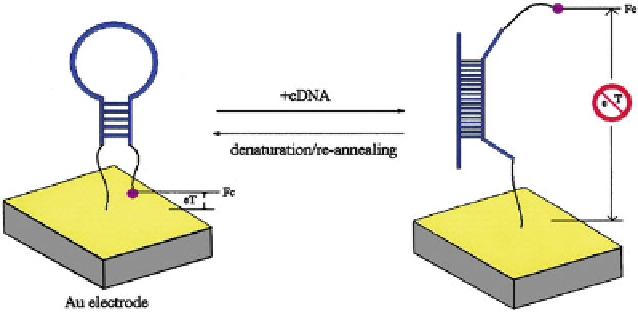Biomedical Engineering Reference
In-Depth Information
Fig. 7 A stem-loop oligonucleotide possessing terminal thiol and a ferrocene group is immobi-
lized at a gold electrode through self-assembly. In the absence of target, the stem-loop structure
holds the ferrocene tag into close proximity with the electrode surface, thus ensuring rapid electron
transfer and efficient redox of the ferrocene label. On hybridization with the target sequence, a
large change in redox currents is observed, presumably because the ferrocene label is separated
from the electrode surface. Reprinted with permission from [
50
]. Copyright 2003 National
Academy of Sciences, USA
Since this initial report, the Plaxco group has made a number of significant
advances to the E-DNA platform [
52
]. Most notably, by inclusion of DNA aptamers
as receptors, these folding-based sensors have been generalized to a wide range of
specific protein and small molecule targets beyond nucleic acids. Further, because
E-DNA signaling is associated with a target-induced change in the conformation and
dynamics of the DNA probe and not simply target absorption to the electrode
surface, the approach has been successfully utilized for analyte detection in complex
matrices such as blood serum, saliva, urine, cell lysates, and environmental soil
samples. Due to the high sensitivity of these systems in “dirty” samples coupled with
their operational convenience, these E-DNA biosensors are well suited for potential
commercial applications in pathogen detection, proteomics, metabolomics, and drug
discovery.
4.2 Peptide-Functionalized Metalloreceptors
Alternatively, a number of ferrocene-peptide conjugates are beginning to emerge as
functional receptors for reagentless electrochemical biosensing. Analogous to the
E-DNA platforms, the peptide components in these systems invariably serve as
analyte recognition elements, while the conjugated ferrocene groups impart redox
activity to the receptor. Depending on the biosensor target, the electroactive
receptors can be integrated with electrodes such that electron transfer properties
are altered based on specific analyte-receptor interactions. Given the enormous

Search WWH ::

Custom Search